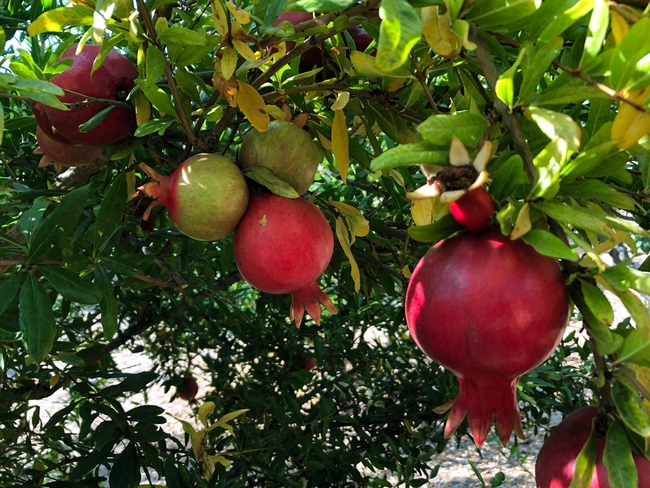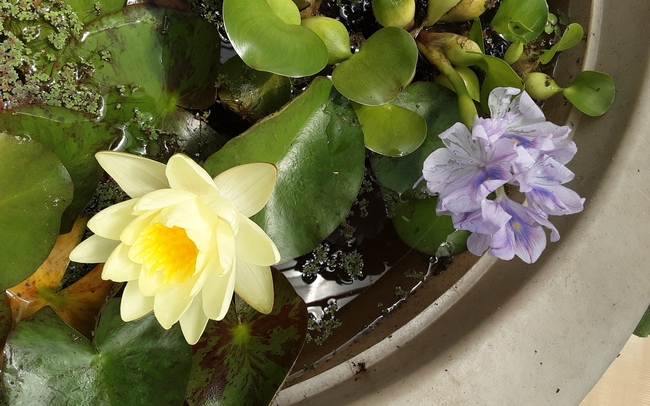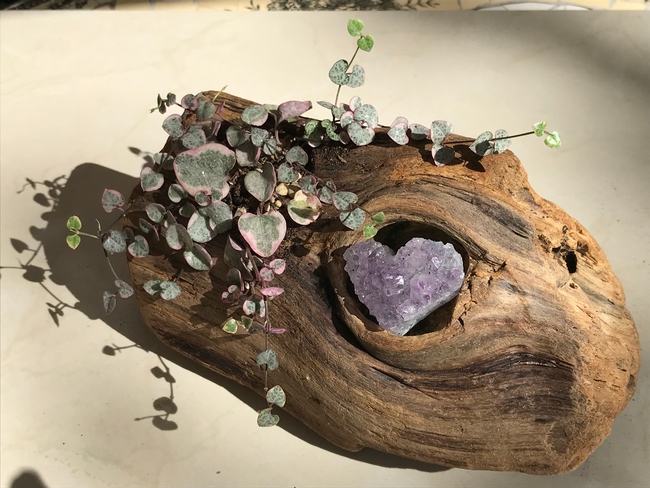- Author: Phyllis Molnar
- Editor: Noni Todd
Wildlife Ponds
By Phyllis Molnar UCCE Master Gardener
What is a wildlife pond? It is a freshwater environment created to support and encourage wildlife including beneficial insects. A true wildlife pond does not use a water pump for air and water circulation. Instead, there is an biotic/abiotic relationship that creates its own ecosystem. Biotic factors are living organisms within an ecosystem: plants, animals, and bacteria. Abiotic factors include non-living components: water, soil and atmosphere.
Your pond can be as simple as an old wash tub, repurposed sink, oak barrel or a water trough. Larger more intricate ponds are designed with a pond liner set into the ground.
The inside of a wildlife pond is made with a base of sand or soil with layers of rocks, stones and old tree branches providing essential access for animals to climb in and out of the pond. Water plants are submerged and floating with leaves flowers or stems partially or fully submerged providing food, shelter and nesting areas. Water plants also help to keep the water clean.
Plants, rocks and wood along the edge of the pond provide habitat for visitors. A backyard wildlife pond is not the best home for large koi or goldfish that will damage water plants and attract raccoons and other mammals. Mosquito fish and mosquito dunks in the pond are used to minimize mosquito development. Avoid using chemicals in or near wildlife ponds. Birds, bats, insects and other animals that use the wildlife pond as a source of fresh water can be harmed.
A well-developed pond will be a home to damselflies, dragonflies, frogs and other aquatic lifeforms. It's a joy to sit quietly and watch the activity around your wildlife pond, a wonderful and beautiful asset for your garden.
- Author: Tami Reece
- Editor: Noni Todd

Transform Your Lawn
By Tami Reece UCCE Master Gardener
Where did lawns come from? Have they always been a part of the American landscape? Lawn's first appeared around the 1600's in Europe, which makes sense since the mild and damp climate of Europe kept the grass lush and green. During the 16th Century Renaissance, lawns were grown by the wealthy in both France and England but were likely planted with chamomile or thyme rather than actual grass-type plants.
Some of the earliest lawns were the grasslands around medieval castles. This kept the area clear so guards could see approaching friends or enemies. These grasses were kept short mostly with the use of farm animals which also added needed fertilizers. Through the ages and as emigrants migrated to North America, they brought their love of green open spaces in and around their homes. While this may work in the eastern to southern states, where year-round moisture is typical, it does not work as well in the Mediterranean climate of California with our mild winters and warm dry summers. And with changing weather patterns, it may not continue to work in our eastern states either.
If you would like to exchange your thirsty lawn with a more drought tolerant option, perhaps chamomile or thyme, to have a landscape reminiscent of early Europe, join UC Master Gardeners on Saturday, September 16th, 2023, at 10:00 to 12:00 p.m. at the Garden of the Seven Sisters Demonstration Garden at 2154 Sierra Way in San Luis Obispo. Methods of lawn removal will be discussed including sheet composting and lasagna gardening, which is a no-dig gardening technique that attempts to mimic the natural soil-building process. We'll also discuss solarization, physical removal of grass and herbicides. You will learn about sustainable ground covers and grasses that require little water or mowing and are amenable to foot traffic. Several samples of lawn alternatives will be available for viewing. Both chamomile and thyme are growing in our Lawn Alternative Plots at the Centennial Demonstration Garden and Garden of the Seven Sisters.
If you want your water bill to go down, the beauty of your landscape to go up, and more time sitting on the porch drinking lemonade rather than mowing, please join us this Saturday, September 16th. The workshop is free and open to the public. Be prepared for warm weather and bring a hat and water. Docents will be available after the workshop until 1:00 pm. If inclement weather, the workshop will be canceled.
Advice to Grow By Workshops
Our next Advice to Grow By Workshop will be October 21st, 2023, at 10:00 to 12:00 p.m. in our Garden of the Seven Sisters Demonstration Garden at 2154 Sierra Way, San Luis Obispo. The topic will be “Vertical Vegetable Gardening.” The workshop is free and open to the public. Docents will be available after the workshop until 1:00 pm. If inclement weather, the workshop will be canceled.
You can view workshops on Instagram live at slo mg or visit our You Tube channel at “San Luis Obispo County UC Master Gardeners.”
Visit our website at ucanr.edu/sites/mgslo/ or email questions to anrmgslo@ucanr.edu.
UCCE Master Gardener Helpline offices:
San Luis Obispo: 805-781-5939 (Monday and Thursday 1:00 to 5:00)
Arroyo Grande: 805-473-7190 (Wednesday 10:00 to 12:00)
Templeton: 805-434-4105 (Wednesday 9:00 to 12:00)
- Author: Megan Edwards
- Editor: Noni Todd
String of Hearts
By UCCE Master Gardener Megan Edwards
Ceropogia woodii
Planting areas: USDA Zone 9-10
Size: 2” tall with 4-9 ft vines
Bloom season: spring and summer
Exposure: 3-4 hrs indirect sunlight
Pruning needs: minimal
Water needs: minimal
“Sweet Hearts”
Among the many varieties of succulent-like evergreen trailing vines, String of Hearts is sure to steal your heart! This native of Zimbabwe and South Africa is also known as the Rosary Vine for its aerial tubers which appear as small white beads. Its cascading vines with mauve vase-like blooms, petite heart-shaped leaves of mottled green, or variegated pink, cream and green, make it the darling of hanging baskets, shelves, and windowsills. Let's look at four important care habits that promote healthy “hearts”: light, temperature, watering, and repotting.
String of Hearts does well when it receives three to four hours of bright indirect sunlight, followed by afternoon shaded. Petals which receive too little sunlight will become more pale and less marbled, while those with too much sun can be scorched and show curled brown leaves.
Ambient temperatures of 60ºF or above, and humidity of 40 to 50% is ideal for String of Hearts. However, if this temperature range is unpredictable, it's safer to grow String of Hearts in pots that can be relocated inside when the temperature dips too low.
With its succulent-like features, this plant does not tolerate wet soil for long and can suffer root rot, however, a blend of well-draining succulent and cactus soil helps to avoid this issue. Give String of Hearts a thorough watering during the spring and summer when the top two to three inches of soil is dry. Limit watering for two to three week periods during its fall and winter dormancy.
A healthy String of Hearts will fair better when re-potted during the summer every two or three years. Beware however, that it may show transplant shock from damaged roots with less ability to transport water and nutrients, causing the leaves to temporarily appear curled.
With these simple care habits in mind, what's not to love about sweet String of Hearts!
Advice to Grow By Workshops
Our next Advice to Grow By Workshop will be September 16th, 2023, at 10:00 to 12:00 p.m. in our Garden of the Seven Sisters Demonstration Garden at 2154 Sierra Way, San Luis Obispo. The topic will be “Turf Replacement-lawn removal and lawn alternatives.” The workshop is free and open to the public. Docents will be available after the workshop until 1:00 pm. If inclement weather, the workshop will be canceled.
You can view workshops on Instagram live at slo mg or visit our You Tube channel at “San Luis Obispo County UC Master Gardeners.”
Visit our website at ucanr.edu/sites/mgslo/ or email questions to anrmgslo@ucanr.edu.
UCCE Master Gardener Helpline offices:
San Luis Obispo: 805-781-5939 (Monday and Thursday 1:00 to 5:00)
Arroyo Grande: 805-473-7190 (Wednesday 10:00 to 12:00)
Templeton: 805-434-4105 (Wednesday 9:00 to 12:00)
- Author: Tami Reece
- Editor: Noni Todd

Pomegranate
By Tami Reece UCCE Master Gardener
Common name of plant: Pomegranate
Scientific name: Punica granatum
Planting area: Sunset zone 7-10
Size: 12 to 20 feet height and 12 to 15 feet width
Bloom Season: flowers bloom late May to June; fruit ripens September to October.
Exposure: minimum 6 hours full sun.
Pruning needs: prune during dormancy to remove crossing branches and to
open up the center to allow light and air to reach blooms.
Water needs: drought tolerant; however, for good fruit production, irrigate 5 to 6 inches every 10 days.
Snapshot: Pomegranates grow naturally as a shrub but can be pruned into small trees. Pomegranates are deciduous in the interior and desert areas. Along the coast, they may lose only a portion of their leaves in the winter. Pomegranates are cold hardy down to 10F when dormant and must be protected from frost in late fall before full dormancy or early spring when it begins to bud. It is adaptable to different soil types, growing best in deep loam, though it will tolerate sandy and clay soils. In wetter areas, they are prone to root decay from fungal diseases.
Pomegranates can be grown from seed but are easier to propagate by cuttings.
The pomegranate fruit is red-purple in color. The husk has two parts: an outer, hard pericarp, and an inner, spongy mesocarp, which comprises the fruit's inner wall where the arils attach. Membranes of the mesocarp are organized as nonsymmetrical chambers that contain richly red colored arils. The number of arils in a pomegranate varies from 200 to almost 1,400. Pomegranate arils are delicious used in savory recipes, baked goods, sprinkled on salads, pressed into juice, or simply eaten fresh, straight from the fruit.
A good variety to add to your garden is the “Wonderful” pomegranate. It produces beautiful, sweet, delicious ruby red arils with the fruit growing to the size of grapefruits. If you are looking for a mid-size tree to add color and beauty to your landscape and fruit to your table, try planting a low maintenance drought tolerant pomegranate tree!
Advice to Grow By Workshops
We have a new garden! The Centennial Park Demonstration Garden will be open to the public for the very first time on Saturday, August 12, 2023, 8:00 to 11:00 a.m. Join us for a free family friendly event. There will be garden tours, meet and greet master gardener volunteers, a kid friendly fun activity, and much more. The garden is located at Centennial Park, 600 Nickerson Dr. Paso Robles. Hope to see you there!
Our next Advice to Grow By Workshop will be August 19th, 2023, at 10:00 to 12:00 p.m. in our Garden of the Seven Sisters Demonstration Garden at 2154 Sierra Way, San Luis Obispo. The topic will be “Fire Safe Landscaping.” The workshop is free and open to the public. Docents will be available after the workshop until 1:00 pm. If inclement weather, the workshop will be canceled.
You can view workshops on Instagram live at slo mg or visit our You Tube channel at “San Luis Obispo County UC Master Gardeners.”
Visit our website at ucanr.edu/sites/mgslo/ or email questions to anrmgslo@ucanr.edu.
UCCE Master Gardener Helpline offices:
San Luis Obispo: 805-781-5939 (Monday and Thursday 1:00 to 5:00)
Arroyo Grande: 805-473-7190 (Wednesday 10:00 to 12:00)
Templeton: 805-434-4105 (Wednesday 9:00 to 12:00)
- Author: Ardis Neilsen
- Editor: Noni Todd
Aeonium
By Ardis Neilsen UCCE Master Gardener
Aeonium haworthii ‘Kiwi' - an award- winning succulent
Common Names: Aeonium kiwi, pinwheel, tree houseleek, Irish rose
Scientific Name: Aeonium haworthii ‘Kiwi'
Planting Area: USDA 9-11
Size: width 2-3 feet, height 2-3 feet
Growing Season: perennial, year around
Exposure: full sun to partial shade
Pruning Needs: to maintain shape and propagate
Water Needs: moderate
Aeonium haworthii ‘kiwi,' an award-winning hybrid succulent, originated from North Africa and the Canary Islands. England's Royal Horticulture Society designated this plant as a winner of the prestigious “Award of Garden Merit.” It is prized for its tri-colored rosettes and attractive symmetrical shape.
A pink or red ribbon borders the rosette's soft green and creamy yellow petals. The petals are spoon shaped, serrated and grow from one to five inches in diameter. Short slender stems support the rosettes.
Its white or yellow conical flowers bloom during late spring. Since an Aeonium kiwi is monocarpic, once a rosette flowers, the rosette dies. New growth, “pups,” will replace the dead rosette. These pups can be transplanted to ensure the succulent's continued survival.
Aeonium kiwi grows well in coastal and inland Mediterranean climates. Brief periods of frost are tolerated by this hardy but delicate-looking plant.
It prefers direct sunlight when grown in coastal areas and partial shade inland. If the succulent doesn't receive enough sun, the vibrant red leaf border won't appear. If placed by a window with indirect light, Aeoniums can be grown as houseplants.
This succulent prefers well-drained sandy or loamy soil. If grown in a pot, use a succulent or cactus potting soil.
This small shrub's shallow root system requires more frequent but light watering as opposed to infrequent, deep watering, which most succulents typically need. Water as soon as the top inch of soil feels dry.
The plant may go partially dormant during summer, so less water is required. Though if grown in a hot, dry environment, do not decrease watering. Summer might cause some leaf drop. The plant might appear to be dying, but it will rebound in August.
Aeoniums are easy to propagate by cuttings. Propagate during winter when its growth cycle peaks. Start the process by cutting a rosette with a sharp knife, wait for a callus to appear on its stem, insert the cutting into sandy compost, and place in moderate light. Keep the cutting moist until rooted.
This aeonium is pet friendly, deer resistant, salt tolerant, and disease free.
Adding this easy-to-grow succulent to your garden will bring beautiful shape and striking color to your landscape.
Advice to Grow By Workshops
Our next workshop will be August 19th, 2023, at 10:00 to 12:00 p.m. in our Garden of the Seven Sisters Demonstration Garden at 2154 Sierra Way, San Luis Obispo. The topic will be “Fire Safe Landscaping.” The workshop is free and open to the public. Docents will be available after the workshop until 1:00 pm. If inclement weather, the workshop will be cancelled.
Other ways to see or reach us:
You can view workshops on Instagram live at slo mg or visit our You Tube channel at “San Luis Obispo County UC Master Gardeners.”
Visit our website at ucanr.edu/sites/mgslo/ or email questions to anrmgslo@ucanr.edu.
UCCE Master Gardener Helpline offices:
San Luis Obispo: 805-781-5939 (Monday and Thursday 1:00 to 5:00)
Arroyo Grande: 805-473-7190 (Wednesday 10:00 to 12:00)
Templeton: 805-434-4105 (Wednesday 9:00 to 12:00)






